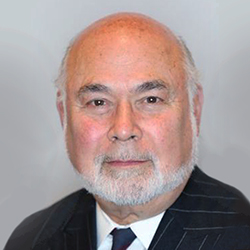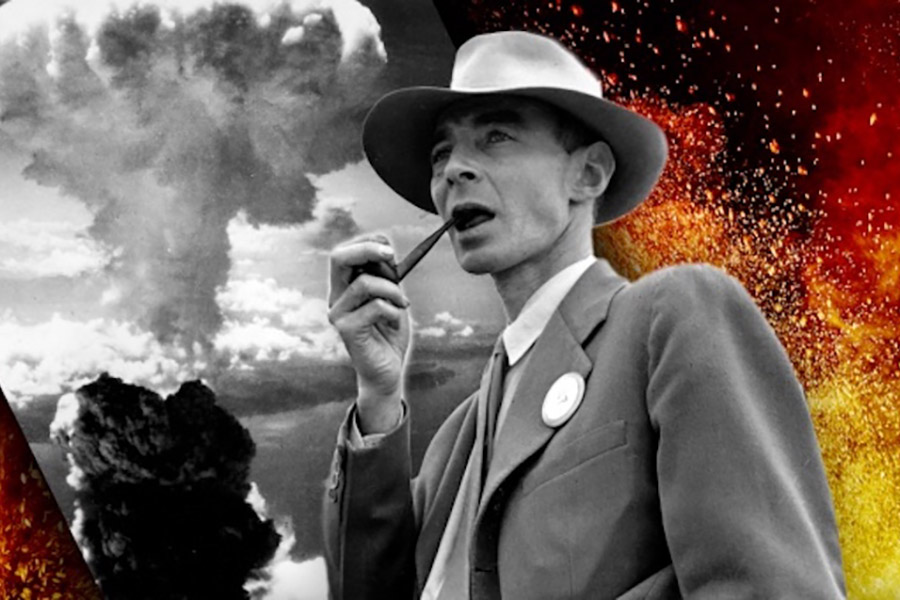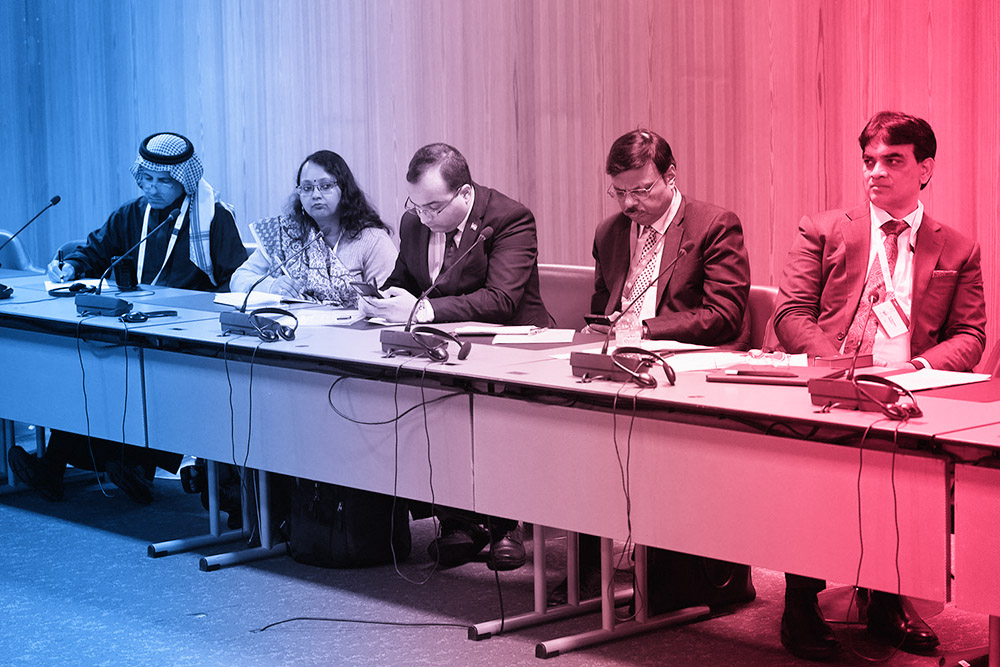By James E. Goodby, David A. Koplow, January 12, 2021
Reprinted with permission, from the Bulletin of the Atomic Scientists: https://thebulletin.org/premium/2021-01/an-ambitious-arms-control-agenda-requires-a-new-organization-equal-to-the-task/
An exceedingly challenging agenda of urgent, important, and diverse arms control issues awaits the incoming Biden administration. The New Strategic Arms Reduction Treaty (New START) will surely be a top priority, as the newly-installed leadership team undertakes to pursue promptly whatever interim steps the Trump administration takes in its waning days, including establishing a structure for future deeper, verifiable cuts in strategic and other nuclear weapons, as well as the possibility of engaging China. Simultaneously, the arms control experts in the new administration will find themselves preoccupied by the tasks of picking up the pieces left from the Trump administration’s wreckage of the Intermediate-range Nuclear Forces Treaty, the Treaty on Open Skies, and the Joint Comprehensive Plan of Action with Iran. Of course, the global coronavirus pandemic has cast new light on the unresolved problem of biological weapons and bio-terrorism, eliciting fresh interest in augmenting the Biological Weapons Convention, and the outrageous uses of Novichok chemical weapons in attempted assassinations by Russia will drive more attention to the implementation of the Chemical Weapons Convention.
Before anyone has a chance to take a breath, the review conference for the Nuclear Non-Proliferation Treaty will be upon us—originally scheduled for May 2020, but postponed to August 2021. This is one of the most consequential diplomatic conclaves, requiring detailed preparation and high-level engagement. The new Biden team will also be charged with revivifying conventional arms control, as the Conventional Forces in Europe Treaty is struggling on life support.
As if that “traditional” arms control agenda were not arduous enough, a host of emerging new technologies must also be confronted before it becomes too late to do anything meaningful about them. These include the surge in malicious international cyber activities and capabilities, the expansion of potentially hostile weapons testing in space, and the emergence of artificial intelligence in lethal autonomous weapon systems, colloquially called killer robots.
An agency to focus on cooperative threat reduction
At the same time that the new Biden team is encountering that daunting array of substantive arms control issues, it should also devote fresh thinking to the proper organization of the executive branch, to enable optimal progress on that ambitious agenda. The secretary of state will be the president’s chief negotiator and policy adviser on international security issues. But even when the State Department is reinvigorated and properly led, it may not retain sufficient expertise, including scientific, technical, military, and other experience, to juggle the bewildering array of arms control issues along with myriad other diplomatic issues that traditionally overflow the expansive State portfolio. The interagency process for addressing national security issues should be expected to be as rambunctious as usual, with different departments vigorously asserting their varying perspectives. The National Security Council staff and other White House components will likewise be pulled in multiple directions simultaneously, scrambling amidst a bewildering constellation of pressing national security challenges and opportunities, all jostling for the time and attention of executive branch and congressional leaders.
One promising measure to assist in coping with these unprecedented opportunities and dangers would be an agency to focus on that unique type of international diplomacy known as “cooperative threat reduction”—call it the Cooperative Threat Reduction Agency. As the name implies, such an agency could address a broader agenda than is usually implied by “arms control and disarmament.” The expansive scope could include, for example, the type of transparency measures agreed to in the Organization for Security and Co-operation in Europe forums. It could also include the types of cooperative programs undertaken over several years under the Nunn-Lugar legislation. Such an agency would be capable of assembling the technical and other expertise necessary for providing novel advice to policy makers on issues like cyber matters and artificial intelligence. But it could also support “traditional” negotiations like continuing to reduce the nuclear threat, with analysis and with personnel, particularly with regard to demanding verification puzzles.
It is worth considering, in addition, whether some of the functions currently within the bailiwick of entities such as the National Nuclear Security Administration (a quasi-independent entity within the Energy Department) and the Defense Threat Reduction Agency (within the Defense Department) could be rationally allocated to a new Cooperative Threat Reduction Agency. The National Nuclear Security Administration is responsible for building, testing, maintaining, and eventually dismantling the nation’s nuclear weapons, and for the “stockpile stewardship” programs that ensure their continuing vitality. Each of those functions is intimately connected to the arms control and nonproliferation processes, including the operation of the Comprehensive Nuclear Test Ban Treaty, so perhaps they should be amalgamated into a new structure.
Similarly, the Defense Threat Reduction Agency manages the on-site inspection provisions of nuclear arms control treaties, including sending US observers into Russian facilities and receiving their counterparts on reciprocal visits. The expertise accumulated by these inspections has direct applicability for the negotiation of the next generation of arms control agreements, so again there could be advantages in structuring the bureaucratic wiring diagram to bring that expertise inside a new agency. Although Nunn-Lugar agreements were negotiated by a State Department official (Goodby), the Defense Threat Reduction Agency has exercised the lead responsibility for implementing the program. This work has facilitated the destruction of nuclear and other weapons and weapons-related capabilities in the former Soviet Union and multiple other countries.
It is also useful to take a fresh look back at President John F. Kennedy’s 1961 idea of “a new agency of peace.” As his idea was implemented, the agency was organized to lead US policy regarding the full array of arms control and disarmament topics and to ensure that they would be consistent with and integrated into national security policy more broadly and foreign policy as a whole.
This agency was legislated into existence as the United States Arms Control and Disarmament Agency. It was charged by its statute to “provide the essential scientific, economic, political, military, psychological, and technological information upon which realistic arms control and disarmament policy must be based.” Among its key functions were “the preparation for and management of United States participation in international negotiations in the arms control and disarmament field” and “the preparation for, operation of, or as appropriate, direction of United States participation in such control systems as may become part of United States arms control and disarmament activities” (Arms Control and Disarmament Act 1961).
Future exercises in arms control might assume many different forms: legally-binding treaties and executive agreements, politically-binding confidence building measures and rules of the road, parallel but unilateral patterns of reciprocal national self-restraint, and other innovative patterns. Some pundits have asserted that the heyday of traditional arms control has passed and the mechanisms of the future will look very different. In some areas, numerical limitations—the traditional fodder for an arms control treaty—may be less relevant than other innovative, yet-to-be-developed practical means for avoiding conflict in the deployment and use of new technologies. But whatever form the next generation of arms control and disarmament measures might assume, they will need an active, focused, and well-resourced bureaucratic entity to lead the campaign against all-too-traditional resistance.
An examination of the Arms Control and Disarmament Agency’s impressive record of accomplishments (and some failures) between 1961 and 1999, when it was disestablished, can help identify some ideas and options for its potential successor today. There is also a question of strategy regarding timing: whether the Biden administration should immediately undertake the heavy lifting necessary to create such a new entity early in 2021, or whether it should instead prioritize a series of lower-profile organizational initiatives (such as creating a new White House Special Assistant position, as described below) while tackling the substantive arms control agenda, and defer the creation of a new agency until after the initial burst of urgent items has been dealt with.
The Arms Control and Disarmament Agency’s history
The Arms Control and Disarmament Agency was physically housed inside the Department of State headquarters building, and, when circumstances were propitious, it routinely coordinated closely with State in the development and execution of policy. The agency strengthened the Secretary’s hand in international negotiations and in domestic politics by providing a cadre of highly qualified scientists and other experts. But the agency remained statutorily independent and for the most part sustained a unique perspective on the issues, so intense policy clashes with State were not infrequent.
Not surprisingly, intervals of success were interrupted by backlashes, and the agency suffered repeated purges and periods of sharply reduced influence, when its senior ranks were captured and populated by White House appointees who were skeptical about, or openly hostile to, the whole concept of arms control.
Nevertheless, the agency can fairly claim the lion’s share of the credit for numerous arms control success stories, starting with the Limited Test Ban Treaty of 1963. As one of us (Goodby) has detailed elsewhere, the fledgling agency served as an indispensable adjunct to President Kennedy’s White House staff in the development, drafting, and negotiation of this vital agreement to legally prohibit the explosive testing of nuclear devices in the atmosphere, under water, and in outer space (Goodby 2017). Right from its start, the young agency provided crucial intellectual and political impetus, challenging the perspectives of larger, more well-funded bureaucracies such as the State and Defense Departments, which were naturally inclined to prioritize other aspects of their respective, very broad, portfolios.
Other important contributions to national security followed intermittently. The agency spearheaded the negotiation of the Nuclear Non-Proliferation Treaty, which was completed in 1968. Likewise, the articulation of the vital 1967 Outer Space Treaty and the 1972 Biological Weapons Convention would not have been possible without the agency’s initiative, leadership, and diligence. It furnished conceptual and technical advice and the key leadership in the Geneva negotiations that contributed to the successful conclusion of the 1972 Interim Agreement limiting US and Soviet strategic nuclear forces (SALT I) and the Anti-Ballistic Missile Treaty. This was the beginning of the succession of treaties limiting and reducing US and Soviet, now Russian, long-range and intermediate-range nuclear forces.
Of course, the agency suffered its share of disappointments and defeats as well, and it was always intensely controversial. Opponents complained that it was too single-minded in its pursuit of its statutory mandate and alleged that it pressed too vigorously for “arms control for the sake of arms control,” with insufficient attention to the problems of verification of compliance with treaties and of their effective enforcement. As the late Congressman John Lewis would have put it, the agency “made good trouble” for a government that might otherwise have drifted toward different priorities and tactics.
Ultimately, the Arms Control and Disarmament Agency was disestablished in 1999, and its functions and personnel were folded into the State Department.
Why was the Arms Control and Disarmament Agency successful?
Several characteristics contributed to the agency’s success as a bureaucratic gadfly in pursuit of arms control. High on the list would be its small size and singular mission. The agency’s staffing level was generally around only 200 personnel, enabling a bureaucratic nimbleness that larger entities could not rival. Ideas could percolate quickly from the working level to the front office, and information and instructions could flow downward promptly. By focusing on the single mandate of arms control and disarmament, the agency was able to devote all its resources to the problem, in contrast to the larger agencies, which were always pulled in multiple directions by their more diverse interests and responsibilities.
The agency was also able to attract and retain an extraordinary work force. It received detailees from both the foreign service and the military services and recruited a unique pool of experts in diplomacy, military matters, economics, sciences, law, operations analysis, and other disciplines, most of whom exhibited strong personal identification with the agency’s mission. It made exceptionally good use of the Intergovernmental Personnel Act, which enabled it to recruit talent from universities for renewable two-year stints to augment its capabilities especially in chemistry, biology, and physics. Morale was high, at least when the political conditions enabled positive movement on arms control initiatives.
The effects of the agency’s prescient statutory mandate were significant, too. The director was appointed by the president and confirmed by the Senate, and was designated as the “principal advisor to the Secretary of State and the President on arms control and disarmament matters”—guaranteeing the agency “a seat at the table.” The director had “primary responsibility” under the secretary for arms control and disarmament matters within the government, bolstering the weight that all agency staffers would carry in sometimes-fractious interagency policy debates. When the director enjoyed the personal confidence of the president and the secretary of state, the agency’s clout could be far greater than its small size might suggest.
Rationales for a new Cooperative Threat Reduction Agency today
Three principal arguments underpin the advocacy for reinventing an agency possessing some of the characteristics of the defunct Arms Control and Disarmament Agency—and they are interestingly similar to the rationales recently advanced for the establishment of the US Space Force as an autonomous entity. First, creating this new agency would vividly illustrate the symbolic points that the government and the country as a whole care about this important topic and recognize that the future will demand greater emphasis on this cluster of issues. The dangers to humanity are profound and almost unique, and a new structure will be needed to cope with them.
Second, creating a new cooperative security agency would acknowledge the value of an institutional entity with a laser-like focus and overarching responsibility for this topic. Even though other agencies will of course continue to have large stakes in the field and will continue to play major roles, especially in implementation, there is value in having a unitary point of contact—a single senior leader (and support staff) who would be responsible for thinking about and working on nothing other than this issue every day. The new agency would not be a “czar,” but would be a place where the ball starts rolling—where effective leaders could assert ideas and allow them to germinate.
Third, this new agency would, like the Space Force, be uniquely capable of creating a career track to recruit, train, promote, and retain a cadre of dedicated professionals who would seek this specialization and commit themselves to its pursuit. In other polymath bureaucracies— the State and Defense Departments, for example—career employees are routinely rotated through a series of very different types of assignments. That practice promotes broad-gauged and big-picture perspectives, but there is conversely something to be said on behalf of building true long-term expertise and personal and institutional memory.
Institutional design options
It would be premature at this point to propose the precise contours of a new agency, but there are three important choices that the drafters of a new Cooperative Threat Reduction Agency statute would have to consider in establishing it.
First, should the new entity be focused solely on nuclear weapons issues, or should it, like the earlier Arms Control and Disarmament Agency, have across-the-board arms control responsibilities?
In any accounting, nuclear weapons are surely of supreme importance; they are truly of existential character. And the agenda of nuclear weapons-related topics is certainly wide and daunting, stretching far beyond the question of extending New START and negotiating its successor, and avoiding a diplomatic train wreck at the NPT Review Conference. The Comprehensive Nuclear Test Ban Treaty has been ratified by 168 countries, but not by the United States and seven others whose participation is necessary to bring it into force, so some concerted effort will be required in both domestic and international political operations. Nuclear relations with Iran and North Korea remain fraught, and the global action agenda also includes the effectuation of salutary “nuclear weapon-free zones” in the Middle East and elsewhere. Even more ambitiously, a new agency could assume a primary role in the effort to forge an international joint enterprise in pursuit of the complete abolition of nuclear weapons. So there would be plenty of hard, complex work to be undertaken, even if the new entity were confined to an exclusively nuclear mission.
On the other hand, the rest of the multifaceted arms control agenda is imposing, too, and in need of additional support. As noted above, the more familiar topics of chemical and biological weapons have taken on a new urgency, and the need is apparent to explore possible international regulation of cyber, space, robotic, and other weapons before a possibly-fleeting window of opportunity slams shut. Resuscitating the Open Skies Treaty and somehow restoring the fundamentals of conventional arms control in Europe will also demand fresh energy. Asia will take on greater urgency in all international security matters. Perhaps a broader mandate could also generate valuable synergies, with ideas from one sector profitably being applied elsewhere by a cooperative threat reduction agency with a more comprehensive statutory scope.
Second, what should be the new agency’s relationship with the Department of State?
The Arms Control and Disarmament Agency was something of a hybrid in this regard: the director was a principal adviser to both the President and the Secretary of State. On the one hand, the connection to the White House represented the agency’s independent clout; on the other hand, the agency personnel were generally most effective when they dovetailed closely with State, and the statute recognized that arms control policy must be conceptualized as one component of overall foreign and national security policy. The fact that the agency was housed in the main State building facilitated routine cooperation. Proximity made it easier to conduct the hallway consultations that lubricate the machinery of government.
Third, should the agency be devoted solely to the tasks of policy formulation and negotiation, or should it additionally have responsibility for day-to-day implementation and verification of any agreements that come to fruition?
The original statute envisioned that the Arms Control and Disarmament Agency might itself operate or direct the “control systems” established pursuant to arms control agreements. In other words, it was thought that this small agency might play a key role in managing “national technical means of verification” (such as photoreconnaissance satellites) and in conducting on-site inspections in foreign lands. In fact, however, the agency never exercised those large and expensive missions. Doing so would have sacrificed its single-mission focus and the cost of such programs would have led to the tail wagging the dog. With the addition of functions like some of those currently carried out by the Defense Threat Reduction Agency and the National Nuclear Security Administration, as described above, that outcome might be altered for any new agency, at the expense of compromising the benefits of small size.
Alternatives on timing
Should the Biden administration undertake an initiative to create a new cooperative threat reduction agency, two main alternatives appear with respect to the timing. First, prudence might counsel a program of starting small in bureaucratic reforms, so at least the first months of 2021 could be fully devoted to coping with the barrage of substantive arms control topics surveyed above. Cabinet officers and a small cadre of experts will be preoccupied with the most urgent tasks of dealing with New START, the NPT review conference, the Joint Comprehensive Plan of Action with Iran, and so on. Several of those topics may engage congressional energies, as well. It might excessively overburden the system to try to simultaneously tackle the sure-to-be-controversial challenge of negotiating, drafting, and legislating a comprehensive statute for a new independent agency.
Instead, a deft strategy for accomplishing institutional reform might start with more modest steps that could be accomplished entirely within the executive branch, not requiring fresh legislation. For example, President Eisenhower had established the position of Special Assistant to the President for Disarmament in 1955. In the following two years, the Eisenhower administration created a whole new panoply of arms control measures and elevated the subject to a public visibility not seen since the first days of the nuclear era. Today, the Biden administration might logically create a position such as Special Assistant to the President for Cooperative Threat Reduction to manage that category of important issues. The Special Assistant, by direction of the President, could be assisted on a day-to-day basis by the directors and staffs of the National Nuclear Security Agency, the Defense Threat Reduction Agency, and elements of the Department of State, as designated by the Secretary of State.
Technical support could also be derived from a charge to the White House Office of Science and Technology Policy to take on additional responsibilities in this area, or perhaps to create a separate companion office within the White House dedicated exclusively to cooperative threat reduction technical issues and endowed by proximity to the Oval Office with sufficient visibility and clout. Another idea could be a “National Cooperative Threat Reduction Advisory Commission” consisting of private citizens (senior former diplomats, retired military and naval officers, scientists, and senior business executives) that could be created by Executive Order, in cooperation with the Congress, to advise the President on which cooperative security issues deserve top priority and which can safely be deferred.
Any of those variants could provide an important boon to arms control and national security policy, and any of them could be instituted quickly, without unduly distracting executive and legislative actors from the substantive priorities. The establishment of a truly autonomous agency could then follow in due course.
The second broad alternative strategy would be for the new administration to plunge ahead immediately with the effort to establish the new agency. Two primary arguments support this impulse. First, none of the substantive agenda items surveyed above is likely to be susceptible to quick and easy resolution. Each of them will demand patient, sustained effort—in conceptualizing additional initiatives, navigating them through the US bureaucracy, negotiating with one or more other countries, and shepherding them through the Senate. If institutional reform, such as the creation of a new Cooperative Threat Reduction Agency, is relegated even temporarily to a back burner until the most pressing matters are resolved, the time may never be truly ripe to reprioritize it.
Second, the whole point of creation of a new agency is that this type of entity can contribute powerfully to the successful accomplishment of the substantive agenda. Cooperative threat reduction is so challenging, and the odds against success are so great, that all possible assets should be marshalled to help the enterprise succeed.
In conclusion, unless the nations of the world find it possible to create cooperative security regimes, humanity faces a bleak future. Nothing can be more important to any American administration than to prevent the use of nuclear weapons and of bioweapons, either of which can bring an end to civilization and all that has made life so worth living. This task deserves the highest priority among national security issues.
————————————————————————————
The authors dedicate this essay to former Secretary of State George P. Shultz, tireless champion of a world free of nuclear weapons, on the occasion of his 100th birthday on December 13, 2020.
Disclosure statement
No potential conflict of interest was reported by the authors.
References
Arms Control and Disarmament Act. 1961. Public Law 87-297, sec. 2. https://uscode.house.gov/view.xhtml?path=/prelim@title22/chapter35&edition=prelim
Goodby, J. E. 2017. “The US Arms Control and Disarmament Agency in 1961–63: A Study in Governance.” Hoover Institution Essay, July 18. https://www.hoover.org/research/us-arms-control-and-disarmament-agency-1961-63
Jonathan Granoff is the President of the Global Security Institute, a representative to United Nations of the World Summits of Nobel Peace Laureates, a former Adjunct Professor of International Law at Widener University School of Law, and Senior Advisor to the Committee on National Security American Bar Association International Law Section.








